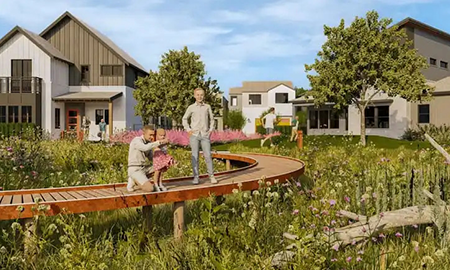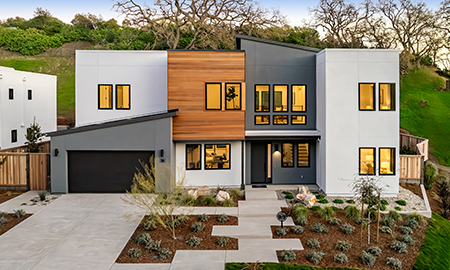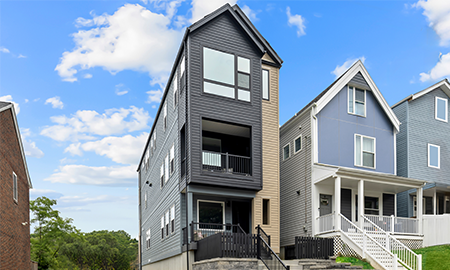Using data-driven design to tackle wellness, sustainability, and affordability head on, the modular concept home is a blueprint for a new standard of living
PITTSBURGH (August 13, 2024) – The America at Home Study today announced the completion of The Picket Fence, a data-driven modular concept home designed and built to address the urgent need for more livable, sustainable, and attainable housing. Born from insights uncovered by the only national longitudinal consumer study capturing early, peak, and post-COVID consumer perceptions of home, The Picket Fence exemplifies a forward-thinking approach to homebuilding, with its design acting as a blueprint for nationwide learning and adoption. The project is a collaborative effort between the founding partners of the America at Home Study, architect DAHLIN Architecture | Planning | Interiors, development partner Housing Innovation Alliance, and manufacturing partner Structural Modular Innovations (SMI).
Understanding consumer behavior and meeting their expectations is crucial for the future of residential construction, particularly in the face of a deepening housing crisis. Affordability is at an all-time low, with the median US housing price reaching $442,000 in June 2024[1]. The US housing market is undersupplied by 2.1 million units (0.7 million for sale and 1.4 million for rent)2, making it challenging to achieve equilibrium. Homebuilders must adopt a data-informed approach to understanding true consumer needs in order to close this gap.
In response, The Picket Fence is a new three-story urban townhome + accessory dwelling unit (ADU) in Pittsburgh informed by insights from 10,000 respondents over three waves of the America at Home Study. The 660-square-foot ground level studio ADU and 2,007-square-foot two-story townhome target the "Trail Blazer," a millennial demographic seeking a modern and sustainable space for active urban living.
"The Picket Fence represents the paradigm shift that's taken place with the dreams and desires of Americans and how they want to live," said Teri Slavik-Tsuyuki, principal of tst ink, co-founder of the America at Home Study, and chair of the Global Wellness Institute's Wellness Communities & Real Estate Initiative. "We created a living space that caters to changes in how people live today and fosters a sense of community and well-being. The townhome and ADU combination is a unique solution for urban living, and we hope this project inspires other builders to think creatively about the future of housing and the importance of designing homes that truly support the way the people who reside in them really live."
The Picket Fence serves as a framework for builders to take measured risk in delivering housing solutions that exceed consumer expectations, align with household financial realities, and are easier to construct.
"This project started with a conversation about how we could shift the homebuilding industry towards more innovative practices," said Dennis Steigerwalt, president of the Housing Innovation Alliance. "The Picket Fence aims to motivate builders and architects to explore systems-built construction solutions for delivering healthier, high-performance homes. With well-defined goals, measurable results, and tangible lessons learned, The Picket Fence offers a valuable model for the homebuilding sector that can be replicated in just about any market. We believe this approach will help industry professionals remain competitive and create lasting change."
Livability: Wellness-Focused Design Objectives for Modern Functionality
From the outset, all stakeholders in The Picket Fence aligned on integrating data-driven design principles with a cost-effective and sustainable systems-built housing approach – volumetric modular construction (VMC) – resulting in a home that meets modern functionality needs and elevates wellness standards.
One of the lasting insights from Wave 3 of the America at Home Study, which guided the home's design, is that wellness is a key purchase motivator, and is the key reason consumers made decisions about sustainability features, technologies, and community attributes. The study also highlighted the growing importance of efficient and flexible living spaces, as well as an increased acceptance of smaller homes and yards.
With 94% of Trail Blazers associating their idea of home with safety, the team also integrated elements that enhance security and community interaction. Separate front and rear entries for each unit and elevated porches create a sense of arrival and safety for residents and guests, while front-facing porches on both units creates enhanced neighborly connection with additional "eyes on the street."
"We operated on a philosophy of ‘spaces, not rooms' when designing The Picket Fence, allowing us to maximize functionality over traditional bed and bath counts," said Ryan White, director of design at DAHLIN Architecture | Planning | Interiors. "Every area of the home serves a purpose to enhance the living experience for residents. By prioritizing social connectivity, wellness, efficiency, and flexibility, The Picket Fence has become a pioneering model for urban living. It not only checks the boxes for consumers, but also fosters a strong sense of community while addressing our current and future housing challenges."
Sustainability: Systems, Technologies, and Lessons Learned for Industry Progress
The Picket Fence integrates advanced systems and technologies developed in collaboration with the United States Department of Energy (DOE), following the spirit of the Zero Energy Ready Home (ZERH) program. Though not fully certified, the home successfully exceeds DOE's ZERH standard, as verified by building performance consultant SK Collaborative.
Three sustainability goals were set for The Picket Fence, with measurements verified by various collaborators. Top-line results for each goal include:
Goal 1 — High-Performance Home: The Picket Fence aimed to create a healthier indoor environment and ensure energy resilience in the face of a major event. The installation of ActivePure technology in the townhome resulted in reductions in particulate matter and residual VOCs by over 74% compared to only 45% in the ADU. This achievement was supported by continuous air monitoring and data analysis from Sanalife, meeting the goal of enhancing indoor air quality.
Goal 2 — 90% Less Waste Generation: Modular construction emphasized reducing, reusing, and recycling building materials. Monitoring the construction process and data provided by SMI revealed that The Picket Fence generated less than 0.5 pounds of waste per square foot, a stark contrast to the 4.4 pounds per square foot typical of site-built homes. This result confirms the project's success in achieving substantial waste reduction, approaching the 90% target.
Goal 3 — Carbon Emissions Reduction: Compared to traditional new home construction, The Picket Fence was able to achieve a 58% reduction in carbon emissions as verified Dr. Maryam Kouhirostamimi of the Construction Management Department at California Polytechnic State University San Luis Obispo, CA and Tangible Materials. This was primarily achieved through strategic material specifications, efficient material use, prefabrication methods, improved energy efficiency, and shorter construction timelines. Although this falls short of the initial target of a 70% reduction, the primary lessons learned include the necessity of collaborating with product manufacturers committed to strong carbon reduction goals and the identification of embodied carbon hotspots, such as insulation, concrete, gypsum board, and windows.
"While our goal of a 70% carbon reduction was ambitious, our achievements underscore the importance of continuous innovation and collaboration to advance sustainable construction practices," said Eric Newhouse, vice president of innovation at SMI. "We're immensely proud of what we've been able to accomplish with The Picket Fence, especially in demonstrating the many benefits of modular construction. By focusing on innovative, eco-friendly building practices, we can ensure that people have access to homes that are not only affordable but also contribute positively to their health and the environment."
Attainability: An Economic Model to Increase Homeownership
Designed to blend within the existing character of the neighborhood, The Picket Fence addresses the concept of Missing Middle Housing by offering two residences on one site, thereby increasing affordability and housing diversity . This dual-dwelling approach enhances economic opportunities that open a pathway for people to move into the neighborhood and offers flexibility for residents to move around within it based on their life stage and needs, while also creating the flexibility to generate rental income.
"Housing attainability is two-pronged: homes need to be affordable to buy or rent, and they need to be cost-effective to build while not sacrificing the livability for the people who will live in them," said White. "To make The Picket Fence a realistic option for consumers, we prioritized efficiency and environmental responsibility in the design while reducing our impact in both the construction process and ongoing living expenses. By focusing on smart design choices and innovative construction methods, we made measurable strides in creating a home that's simultaneously economical and sustainable."
The construction process, including the materials and methods used, influences the carbon footprint and significantly impacts the initial purchase price or rent. Maximizing the site's potential without compromising aesthetic appeal was a core design principle that led to the creation of two units instead of one. Utilizing three stacked volumetric modular structures made the project more economical to build in the factory and transport. The systems and technologies in place not only impact the carbon footprint, but the resident's monthly bills. The Picket Fence uses durable, low-maintenance materials and a whole-home integrated systems approach for optimal performance and cost efficiency. Features such as rheia's innovative home comfort solution, locally made triple-pane windows, air source heat pumps, continuous insulation, and active ventilation and air purification systems contribute to lower operational costs and enhanced air quality, making the home more cost-friendly to live in over time.
The design also plays a crucial role in minimizing operational costs. Features like low-maintenance exterior elements, covered porches and decks, hardscaping, and gravel patios reduce upkeep expenses. Window placement was strategically planned to maximize natural light in the most important rooms, enhancing overall wellness and ensuring cost-effectiveness by focusing investment where it counts most.
A New Dawn for Housing
The housing industry has often lagged in embracing innovation, but The Picket Fence confronts this head-on, showing how creativity and collaboration can improve housing in the future. By uniting design, construction, and manufacturing professionals, The Picket Fence captures the benefits of systems-built construction and presents a model to responsibly address the housing crisis.
"The Picket Fence has set the wheels of innovation in motion, ready to roll out far beyond Pittsburgh," said Slavik-Tsuyuki. "By celebrating our successes, reflecting transparently on the lessons learned, and remaining deeply connected to the needs and desires of consumers, we developed a scalable model that can be recreated in markets all over the country. Envisioning a future where sustainable and attainable housing is truly achievable doesn't feel so far-fetched anymore."
For more information about The Picket Fence, please visit americaathomestudy.com.
About The Picket Fence Concept Home
The Picket Fence is a physical manifestation of the shifts in living behaviors and needs of Americans during early, peak, and post-pandemic times. Envisioned and realized by three women leaders in the homebuilding industry who also serve as the America at Home Study founders, the new factory built concept home is a townhome + accessory dwelling unit in Pittsburgh, Pennsylvania. Completed in summer 2024, The Picket Fence is the collective effort of DAHLIN Architecture | Planning | Interiors (architect), Housing Innovation Alliance (developer), and Structural Modular Innovations, LLC (manufacturer). The intent is to inspire new ways builders and architects can think about designing healthier high-performance homes using modern methods of construction, while maintaining a focus on economic attainability.
About the America at Home Study
The America at Home Study (americaathomestudy.com) was hosted online in three waves, revealing Americans' desire for home purchases, how they feel about and live in their homes, and what changes they'd like to see as a direct result of the COVID-19 pandemic. The first wave took place April 23-30, 2020, with a nationally representative sample of 3,001 consumers 25-74 years of age with household incomes of $50,000+. The second wave took place September 24-November 6, 2020, with 3,935 responses, and the third wave took place October 6-31, 2022, with 3,000 responses. The America at Home Study was spearheaded by community design and marketing expert Teri Slavik-Tsuyuki of tst ink, consumer strategist Belinda Sward of Strategic Solutions Alliance, and architect Nancy Keenan, president of DAHLIN. The second and third waves were further enhanced with Kantar's MindBaseTM consumer attitudinal and generational segmentation, providing deeper insights across 12 unique consumer targets.






